
Ross was the host of the public television series The Joy of Painting, which ran from 1983 to 1994 and still[update] appears in reruns in many broadcast areas. During each half-hour segment, Ross would instruct viewers in the art of oil painting using a quick-study technique that kept colors to a minimum and broke paintings down into simple steps that virtually anyone could follow.[4] Art critic Mira Schor compared him to another PBS television host, noting that the softness of Ross's voice and the slow pace of his speech was similar to Mr. Rogers.
Ross later founded his own successful line of art supplies and how-to books, and also offered painting classes taught by instructors trained in the 'Bob Ross method.' In a 1990 interview, Ross mentioned that all his programs were donated free of charge to PBS stations and that his earnings came instead from sales of his 20 books and 100 videotapes (the total to that date), as well as profits from some 150 Bob Ross-trained teachers and a line of art materials sold through a national supplier. Ross also mentioned on the show 'Towering Glacier' (#2341) that he donated all the paintings made on the show to PBS stations around the country to 'help them out.'
Ross also filmed wildlife footage, squirrels in particular, usually from his own garden. Small animals often appeared on his show, even during some of his trickier works, as he would often take in injured or abandoned squirrels and other assorted wildlife and look after them.
The show can be seen on the PBS oriented Create."
Ross later founded his own successful line of art supplies and how-to books, and also offered painting classes taught by instructors trained in the 'Bob Ross method.' In a 1990 interview, Ross mentioned that all his programs were donated free of charge to PBS stations and that his earnings came instead from sales of his 20 books and 100 videotapes (the total to that date), as well as profits from some 150 Bob Ross-trained teachers and a line of art materials sold through a national supplier. Ross also mentioned on the show 'Towering Glacier' (#2341) that he donated all the paintings made on the show to PBS stations around the country to 'help them out.'
Ross also filmed wildlife footage, squirrels in particular, usually from his own garden. Small animals often appeared on his show, even during some of his trickier works, as he would often take in injured or abandoned squirrels and other assorted wildlife and look after them.
The show can be seen on the PBS oriented Create."









 This is a picture of his sister looking back to the past and forward to the future.
This is a picture of his sister looking back to the past and forward to the future. 


